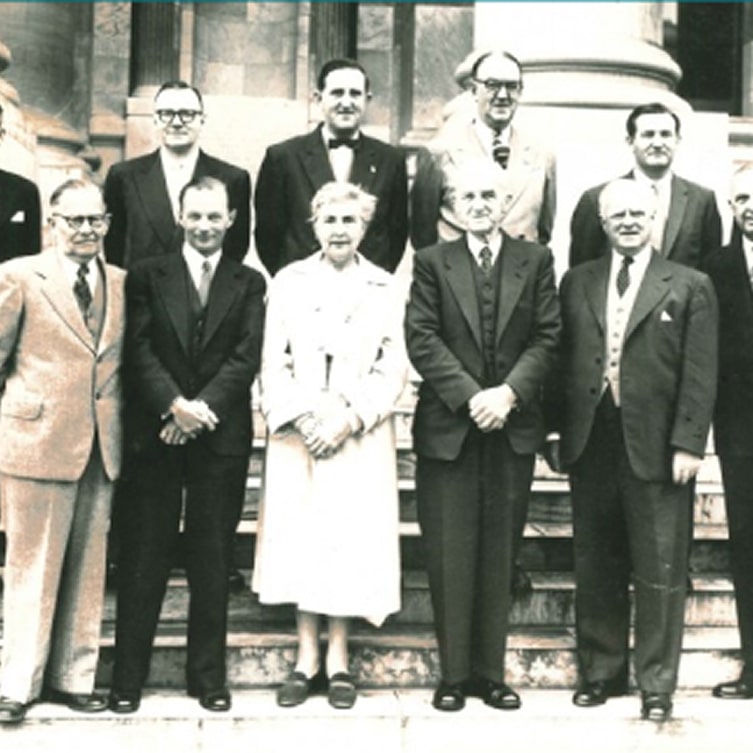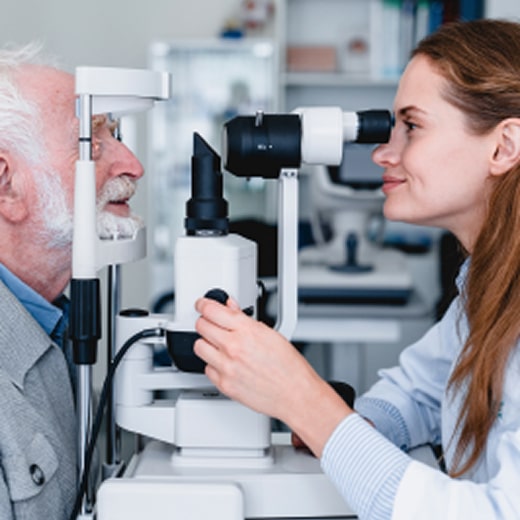Our Legacy of Vision
Honouring Our Founders. Shaping the Future.
Since 1953, Australian Vision Research has funded ground-breaking discoveries in eye health—championed by pioneers like Dame Ida Mann and powered by a commitment to better outcomes for all Australians.

Australian Vision Research was founded in 1953 by a group of ophthalmologists driven to improve eye health through research. Since those early days, we’ve invested millions into ground-breaking projects—supporting discoveries that have shaped clinical practice and deepened our understanding of vision.
One of our most influential founders was Dame Ida Mann, DBE. A leading ophthalmologist from England, Dame Ida relocated to Western Australia after World War II. There, she identified a widespread trachoma epidemic among Aboriginal communities and travelled extensively to diagnose and treat affected individuals.
Dame Ida believed systemic change—not just antibiotics—was the key to addressing this crisis. Her advocacy for better housing and sanitation left a lasting mark on public health in remote Australia. In recognition of her work, she was appointed Dame Commander of the Order of the British Empire in 1980.
Today, her legacy continues through AVR. For nearly seven decades, we’ve partnered with leading specialists, research institutions, and advocates to advance vision science. With the support of our donors, members, and sponsors, we remain committed to a future where fewer Australians face vision loss.
1953
ORIA is established to advance eye research in Australia.
1954
Ida Mann becomes the first female member of the ORIA Board. She leverages her trachoma research, highlighting its prevalence, causing disproportionately high rates of blindness among Aboriginal population of the Kimberley and Western Desert.
1956
An anonymous Sydney based ophthalmologist (“DW”) who had dedicated his life to eye health as a clinician and researcher announced his intention to donate a significant portion of his estate to the ORIA.
1958
ORIA establishes the DW Fund trust deed in the ACT.
1959
The Research Advisory Committee (RAC) was set up to be led by the Research Director
1960
Professor Ida Mann, the Hon Secretary, is the principal author of the paper Experimental Trachoma Produced by a West Australian Virus which is published in the British Journal of Ophthalmology.
1976
The ORIA Board decides that the Director of Research position calls for a tripartite agreement signed by ORIA, the Victorian Eye and Ear Hospital and the University of Melbourne.
1980
Ida Mann is honoured for her many contributions to ophthalmology and made a Dame (DBE).
1994
The Gift of Sight Society is set up to raise funds and build on the capital base for research grants. Its main focus is to attract donations from ophthalmologists and their patients.
1996
ORIA receives a signed letter from the beneficiaries of the copyright from Sydney Long’s artistic works, re-assigning these benefits to ORIA.
1999
Gift of Sight Society rolls out a macular degeneration awareness afternoon and a series of awareness programs for retinal diseases.
2001
An MOU is signed between ORIA and the New Zealand Save Sight Society – an agreement in which ORIA would assess NZ applications for research funds submitted by the research committee of the Save Sight Society.
2002
Gift of Sight Society ceases to exist. RANZCO Eye Foundation (REF) is incorporated as the fundraiser for the ORIA.
2004
REF official launch a fundraising function promoting its mission of supporting research, aiding projects and building community awareness.
2005
REF funds projects to further research in glaucoma and AMD; support sustainable aid for purchase of equipment in the Australasian region as well as projects in East Timor and Myanmar; increase eye health community awareness and coordinate a project with Diabetes Australia (NSW).
2007
REF funds the launch of the Fight Retinal Diseases project involving 10,000 patients/yr to establish a national system to track treatment outcomes for macular and retinal diseases; the Australia and NZ Registry of Advanced Glaucoma Project (ANZRAG); the Rare Eye Disease Surveillance Unit; The Minum Berreng (‘tracking eyes’) Indigenous Project; Australian and international sustainable aid projects in Timor Leste and Myanmar.
2008
REF partners with the Royal Australian College of Surgeons (RACS) and the Fred Hollows Foundation to fund the Central Australia Eye Health Program.
2010
REF funds: • the Australian and NZ Ophthalmic Surveillance Unit (ANZOSU); • Novartis Medical Retina Scholarships; • Central Australian Barkley Integrated Eye Health Program in collaboration with Fred Hollows Foundation; • Kimberley Diabetic Eye Care Program; • East Timior (Timor Leste) Eye Program (ETEP); and • Myanmar Eye Care Program.
2013
A major retrospective of the Australian Art Australia is held at the Royal Academy of Art in London. The Spirit of the Plains by Sydney Long forms part of the exhibition and reproduction rights are granted. An MOU between ORIA and REF is established.
2016
Professor Stephanie Watson becomes the first female Chair of the ORIA Board. ORIA contracts an independent legal institution to develop a constitution, highlighting ORIA’s role in prevention and early intervention in eye disease.
2017
ORIA functions are officially integrated within RANZCO, ratified by the signing of the Service Level Agreement (SLA) between ORIA and RANZCO. SLA states administrative services for ORIA will be provided by RANZCO, with the ORIA Board continuing to oversee the running of the organisation. SLA clearly outlines the roles and responsibilities of RANZCO staff in providing each discrete service to ORIA The RANZCO Eye Foundation (REF) is dissolved.
2018
The ORIA Board announces target of 35% female participation in grant application process. Benchmark data indicates target is being met for both the proportion of females participating and the proportion of females receiving ORIA funding.
Proudly Supported
Together, we’re changing the future of eye health.

AVR is a not-for-profit organisation dedicated to funding and enabling eye and vision research. We work in partnership with world-leading specialists and research institutions to improve clinical outcomes and deliver lasting impact for patients.


Back vision research that will change lives.
We’re driving breakthroughs in eye health, and your support makes it possible.